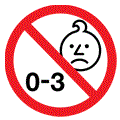Toy Safety
Most children's toys are safe. Accidents involving toys usually happen when a young child plays with a toy that is meant for an older child, or when someone trips over toys that have been left out. The reminders below will give you an idea of how to help your child play safely.
Did you know...
- Most toys in the UK are safe if you follow the instructions. The law says all toys must have a suggested age range so they aren't given to children too young to play with them.
- One of the main causes of toy accidents is toys with small parts. If a child is given a toy designed for an older child they can break it and end up swallowing small parts.
Which toys should I buy?
There are so many great toys on the market it can be hard to choose the right one. If you’re not sure, the tips below will help you choose something safe and fun for your child.
Toys sold by well known, reputable shops are generally safe. Online marketplaces, markets or discount shops may not be. Don’t assume that just because you can buy something it is safe.
Check second hand toys carefully before giving them to your child. A toy library is a good option. They’ll lend you toys that are appropriate and in good condition.
Marks to guide you

A CE mark is required by law on any toy sold in the EU. It is the manufacturer’s claim that the toy complies with European safety legislation.

A Lion Mark is a good indicator of a toy’s safety. It shows that the product has been made by a member of the British Toy and Hobby Association, to a high standard of safety and quality.

Babies and toddlers put nearly everything in their mouths. This is why some toys are marked with age restrictions, in case little ones choke on small parts or loose hair. Look out for this symbol as a helpful guide. It shows toys that aren’t meant for children under 36 months.
Think about special needs too. For example, children with learning disabilities may develop in different ways to other children the same age. Use your judgement and if you’re not sure ask their parents for advice.
Which toys are suitable for my child?
All children develop at different speeds. But even so, it’s best to stick to the age advice on toy packaging. If a baby plays with a toy that has small parts or long fur, they might choke or swallow bits of the toy. Marbles and magnets can also be choked on or swallowed. Magnets are particularly dangerous as they can cause serious problems if swallowed. Toy manufacturers know what is safe and what isn’t so it’s best to follow their age guides.
Sharing toys teaches children good habits but be careful if older children are sharing their toys. What’s safe for a 7 year old might not be safe for a toddler.
More risky toys can still be fun, if you’re there to play with your child. Toys like baking kits, baby bath toys or chemistry sets will help your children learn, but you’ll need to be there to make sure your child doesn’t get hurt. Always follow instructions on the box.
How can I keep my child’s toys safe?
Keeping things tidy and encouraging your child to put toys away helps to keep your home safe. Tidying up things like balloons is especially important. Burst balloons are a choking hazard for young children.
Throwing things away can seem wasteful. However, if a toy is broken or damaged it could go on to cause accidents for other children.
Battery powered toys have usually passed rigorous safety tests. But as the batteries wear out, try to avoid mixing old and new batteries. The older batteries could overheat or leak in the toy.
Batteries in children’s toys are covered by safety regulations. They should either be enclosed by a screw and a secure compartment or need two independent or simultaneous movements to open the battery compartment. Remember that older children may still be able to open secure battery compartments.
Magnets
Magnets are found commonly around the house (desk toys, stress relievers, jewellery) and many children’s toys also include small magnets.
Why are magnets dangerous if swallowed?
Single, small magnets will pass through the body without a problem. If more than one magnet is swallowed or a magnet is swallowed alongside something metal, there is a risk that part of the gut can be caught in between the magnetised objects. This can cause serious damage to the gut, including a hole in the wall of the gut.
What should I do if I think my child has swallowed magnets?
It may not be obvious your child has swallowed a magnet. If you think they may have, take them straight to Accident and Emergency or phone 999. It is likely that they will need an x-ray to find out where the magnets are and how many they have swallowed. They may need an operation to remove the magnets.
Parents are often unsure as to how many magnets might have been swallowed. It is important not to assume just one has been swallowed.
Further useful links:
Child Accident Prevention Trust
Royal Society for the Prevention of Accidents (RoSPA) webpages on:



